Occupational Hygiene and Chemical Safety
VerifiedAdded on 2023/02/02
|17
|5633
|41
AI Summary
This report discusses occupational hygiene and chemical safety in the workplace, focusing on the hazards of neurotoxins. It covers topics such as dealing with hazardous agents, employee exposure, measurement and analysis of occupational exposure, and specific standards and practices.
Contribute Materials
Your contribution can guide someone’s learning journey. Share your
documents today.
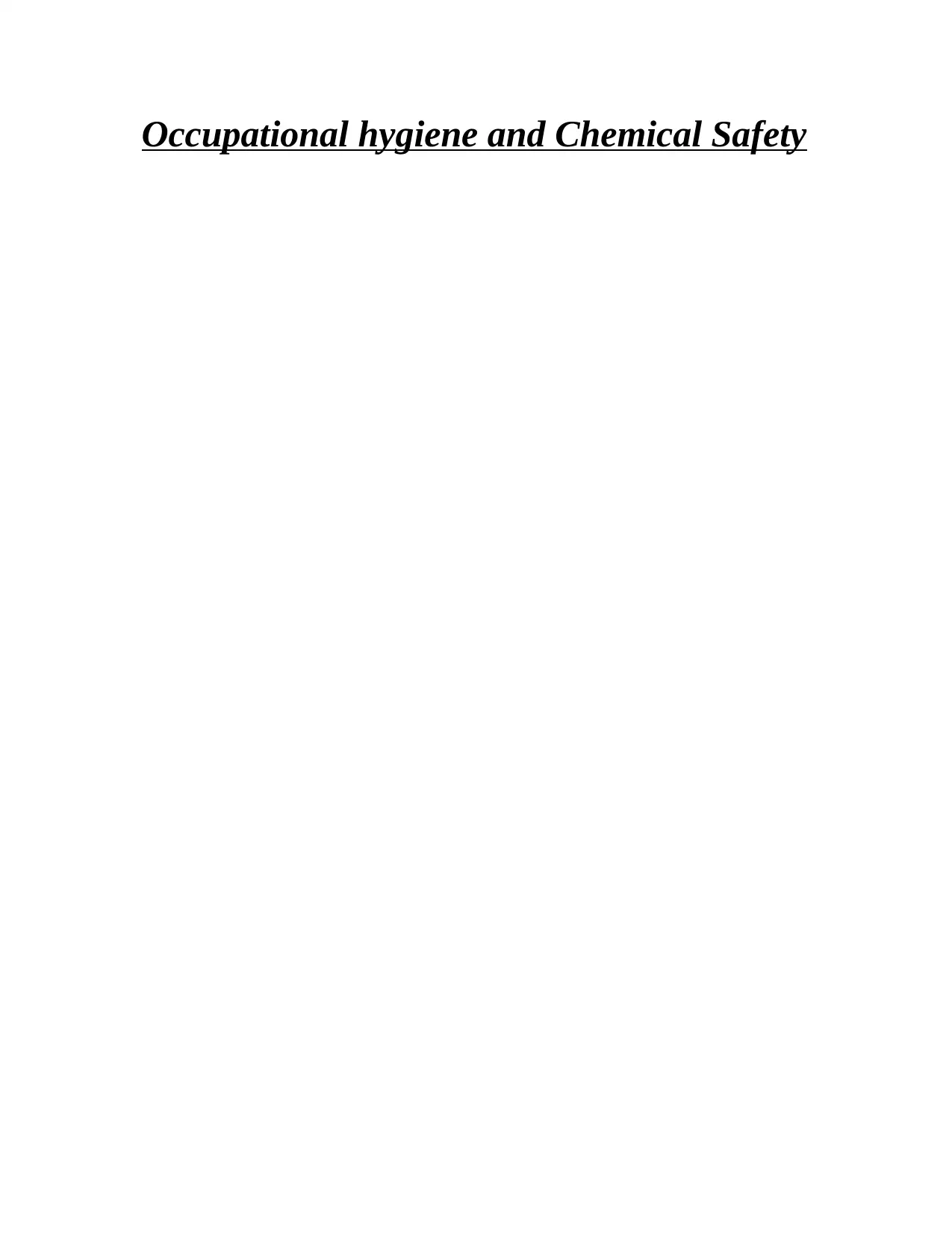
Occupational hygiene and Chemical Safety
Secure Best Marks with AI Grader
Need help grading? Try our AI Grader for instant feedback on your assignments.

Contents
INTRODUCTION.....................................................................................................................................3
MAIN BODY.............................................................................................................................................3
How deals with Hazard agent at workplace.............................................................................................4
How employee may exposed and describe the exposure standard they exist...........................................5
Measurement and analysis of occupational exposure..............................................................................6
Discuss about the Neurotoxin process that generate the hazard, including the identification of inputs,
outputs and waste items...........................................................................................................................7
Determine the physico chemical properties of Neurotoxin, how it can be generated and the mechanism
of exposure in both potential and actual..................................................................................................8
Describe that why Neurotoxin present a risk to employee health and should include the chronic health
affect and acute........................................................................................................................................9
How Neurotoxin hazard should be monitored and analysed..................................................................10
Explain the specific standards, code of practices and method applicable in the exposure.....................11
Different type of monitoring and measurement method or describe the advantages and disadvantages 14
CONCLUSION........................................................................................................................................16
REFERENCES........................................................................................................................................17
INTRODUCTION.....................................................................................................................................3
MAIN BODY.............................................................................................................................................3
How deals with Hazard agent at workplace.............................................................................................4
How employee may exposed and describe the exposure standard they exist...........................................5
Measurement and analysis of occupational exposure..............................................................................6
Discuss about the Neurotoxin process that generate the hazard, including the identification of inputs,
outputs and waste items...........................................................................................................................7
Determine the physico chemical properties of Neurotoxin, how it can be generated and the mechanism
of exposure in both potential and actual..................................................................................................8
Describe that why Neurotoxin present a risk to employee health and should include the chronic health
affect and acute........................................................................................................................................9
How Neurotoxin hazard should be monitored and analysed..................................................................10
Explain the specific standards, code of practices and method applicable in the exposure.....................11
Different type of monitoring and measurement method or describe the advantages and disadvantages 14
CONCLUSION........................................................................................................................................16
REFERENCES........................................................................................................................................17
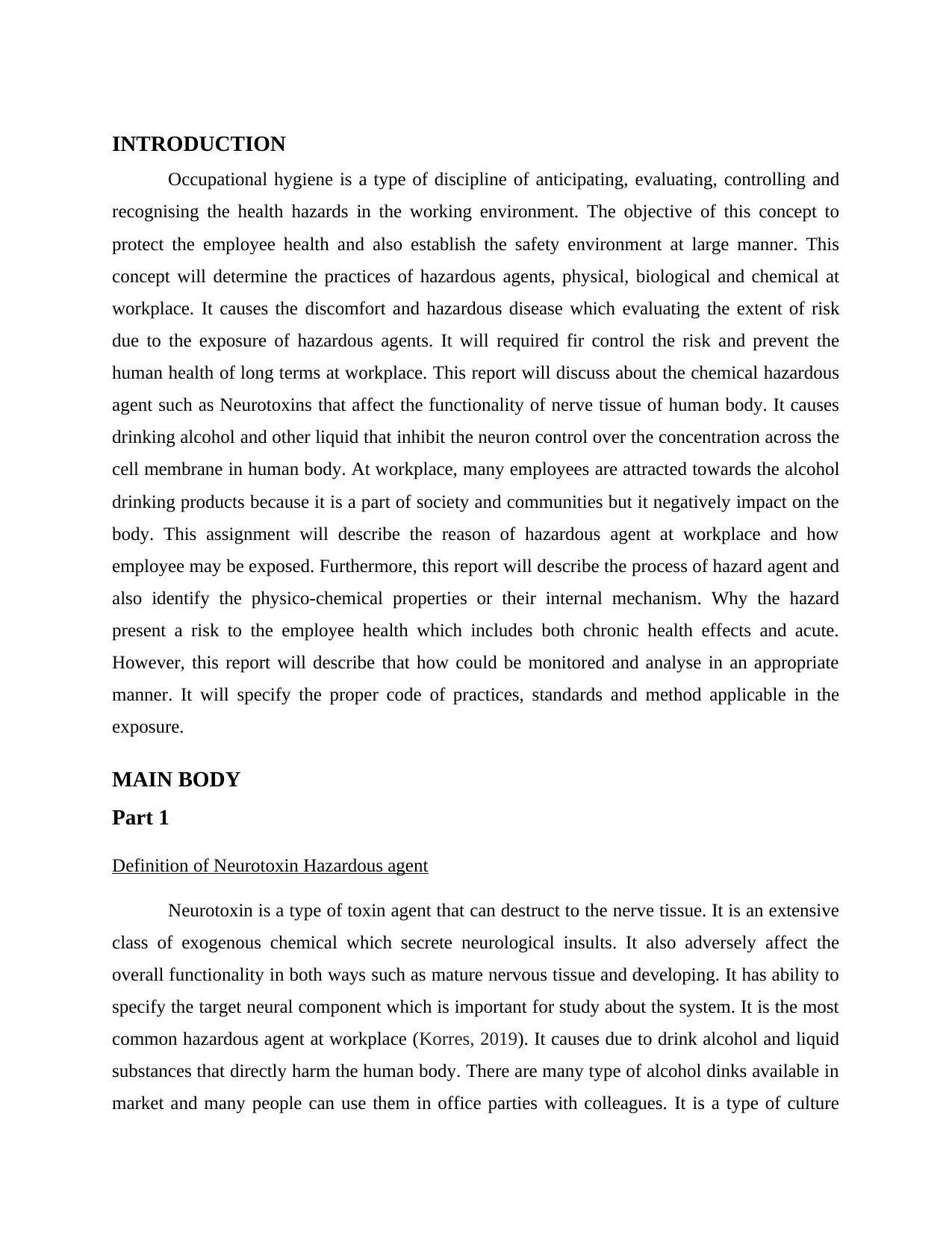
INTRODUCTION
Occupational hygiene is a type of discipline of anticipating, evaluating, controlling and
recognising the health hazards in the working environment. The objective of this concept to
protect the employee health and also establish the safety environment at large manner. This
concept will determine the practices of hazardous agents, physical, biological and chemical at
workplace. It causes the discomfort and hazardous disease which evaluating the extent of risk
due to the exposure of hazardous agents. It will required fir control the risk and prevent the
human health of long terms at workplace. This report will discuss about the chemical hazardous
agent such as Neurotoxins that affect the functionality of nerve tissue of human body. It causes
drinking alcohol and other liquid that inhibit the neuron control over the concentration across the
cell membrane in human body. At workplace, many employees are attracted towards the alcohol
drinking products because it is a part of society and communities but it negatively impact on the
body. This assignment will describe the reason of hazardous agent at workplace and how
employee may be exposed. Furthermore, this report will describe the process of hazard agent and
also identify the physico-chemical properties or their internal mechanism. Why the hazard
present a risk to the employee health which includes both chronic health effects and acute.
However, this report will describe that how could be monitored and analyse in an appropriate
manner. It will specify the proper code of practices, standards and method applicable in the
exposure.
MAIN BODY
Part 1
Definition of Neurotoxin Hazardous agent
Neurotoxin is a type of toxin agent that can destruct to the nerve tissue. It is an extensive
class of exogenous chemical which secrete neurological insults. It also adversely affect the
overall functionality in both ways such as mature nervous tissue and developing. It has ability to
specify the target neural component which is important for study about the system. It is the most
common hazardous agent at workplace (Korres, 2019). It causes due to drink alcohol and liquid
substances that directly harm the human body. There are many type of alcohol dinks available in
market and many people can use them in office parties with colleagues. It is a type of culture
Occupational hygiene is a type of discipline of anticipating, evaluating, controlling and
recognising the health hazards in the working environment. The objective of this concept to
protect the employee health and also establish the safety environment at large manner. This
concept will determine the practices of hazardous agents, physical, biological and chemical at
workplace. It causes the discomfort and hazardous disease which evaluating the extent of risk
due to the exposure of hazardous agents. It will required fir control the risk and prevent the
human health of long terms at workplace. This report will discuss about the chemical hazardous
agent such as Neurotoxins that affect the functionality of nerve tissue of human body. It causes
drinking alcohol and other liquid that inhibit the neuron control over the concentration across the
cell membrane in human body. At workplace, many employees are attracted towards the alcohol
drinking products because it is a part of society and communities but it negatively impact on the
body. This assignment will describe the reason of hazardous agent at workplace and how
employee may be exposed. Furthermore, this report will describe the process of hazard agent and
also identify the physico-chemical properties or their internal mechanism. Why the hazard
present a risk to the employee health which includes both chronic health effects and acute.
However, this report will describe that how could be monitored and analyse in an appropriate
manner. It will specify the proper code of practices, standards and method applicable in the
exposure.
MAIN BODY
Part 1
Definition of Neurotoxin Hazardous agent
Neurotoxin is a type of toxin agent that can destruct to the nerve tissue. It is an extensive
class of exogenous chemical which secrete neurological insults. It also adversely affect the
overall functionality in both ways such as mature nervous tissue and developing. It has ability to
specify the target neural component which is important for study about the system. It is the most
common hazardous agent at workplace (Korres, 2019). It causes due to drink alcohol and liquid
substances that directly harm the human body. There are many type of alcohol dinks available in
market and many people can use them in office parties with colleagues. It is a type of culture
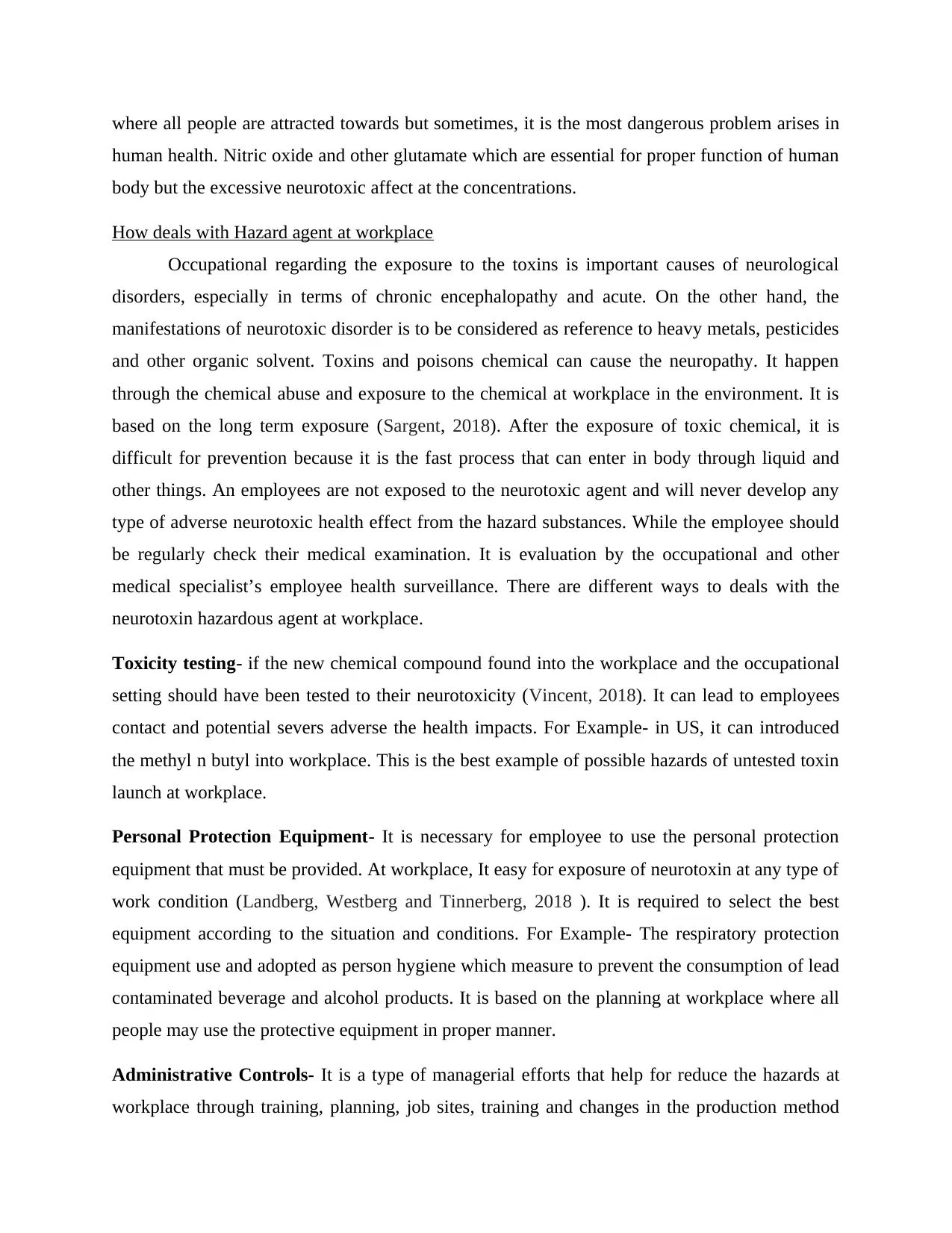
where all people are attracted towards but sometimes, it is the most dangerous problem arises in
human health. Nitric oxide and other glutamate which are essential for proper function of human
body but the excessive neurotoxic affect at the concentrations.
How deals with Hazard agent at workplace
Occupational regarding the exposure to the toxins is important causes of neurological
disorders, especially in terms of chronic encephalopathy and acute. On the other hand, the
manifestations of neurotoxic disorder is to be considered as reference to heavy metals, pesticides
and other organic solvent. Toxins and poisons chemical can cause the neuropathy. It happen
through the chemical abuse and exposure to the chemical at workplace in the environment. It is
based on the long term exposure (Sargent, 2018). After the exposure of toxic chemical, it is
difficult for prevention because it is the fast process that can enter in body through liquid and
other things. An employees are not exposed to the neurotoxic agent and will never develop any
type of adverse neurotoxic health effect from the hazard substances. While the employee should
be regularly check their medical examination. It is evaluation by the occupational and other
medical specialist’s employee health surveillance. There are different ways to deals with the
neurotoxin hazardous agent at workplace.
Toxicity testing- if the new chemical compound found into the workplace and the occupational
setting should have been tested to their neurotoxicity (Vincent, 2018). It can lead to employees
contact and potential severs adverse the health impacts. For Example- in US, it can introduced
the methyl n butyl into workplace. This is the best example of possible hazards of untested toxin
launch at workplace.
Personal Protection Equipment- It is necessary for employee to use the personal protection
equipment that must be provided. At workplace, It easy for exposure of neurotoxin at any type of
work condition (Landberg, Westberg and Tinnerberg, 2018 ). It is required to select the best
equipment according to the situation and conditions. For Example- The respiratory protection
equipment use and adopted as person hygiene which measure to prevent the consumption of lead
contaminated beverage and alcohol products. It is based on the planning at workplace where all
people may use the protective equipment in proper manner.
Administrative Controls- It is a type of managerial efforts that help for reduce the hazards at
workplace through training, planning, job sites, training and changes in the production method
human health. Nitric oxide and other glutamate which are essential for proper function of human
body but the excessive neurotoxic affect at the concentrations.
How deals with Hazard agent at workplace
Occupational regarding the exposure to the toxins is important causes of neurological
disorders, especially in terms of chronic encephalopathy and acute. On the other hand, the
manifestations of neurotoxic disorder is to be considered as reference to heavy metals, pesticides
and other organic solvent. Toxins and poisons chemical can cause the neuropathy. It happen
through the chemical abuse and exposure to the chemical at workplace in the environment. It is
based on the long term exposure (Sargent, 2018). After the exposure of toxic chemical, it is
difficult for prevention because it is the fast process that can enter in body through liquid and
other things. An employees are not exposed to the neurotoxic agent and will never develop any
type of adverse neurotoxic health effect from the hazard substances. While the employee should
be regularly check their medical examination. It is evaluation by the occupational and other
medical specialist’s employee health surveillance. There are different ways to deals with the
neurotoxin hazardous agent at workplace.
Toxicity testing- if the new chemical compound found into the workplace and the occupational
setting should have been tested to their neurotoxicity (Vincent, 2018). It can lead to employees
contact and potential severs adverse the health impacts. For Example- in US, it can introduced
the methyl n butyl into workplace. This is the best example of possible hazards of untested toxin
launch at workplace.
Personal Protection Equipment- It is necessary for employee to use the personal protection
equipment that must be provided. At workplace, It easy for exposure of neurotoxin at any type of
work condition (Landberg, Westberg and Tinnerberg, 2018 ). It is required to select the best
equipment according to the situation and conditions. For Example- The respiratory protection
equipment use and adopted as person hygiene which measure to prevent the consumption of lead
contaminated beverage and alcohol products. It is based on the planning at workplace where all
people may use the protective equipment in proper manner.
Administrative Controls- It is a type of managerial efforts that help for reduce the hazards at
workplace through training, planning, job sites, training and changes in the production method
Secure Best Marks with AI Grader
Need help grading? Try our AI Grader for instant feedback on your assignments.
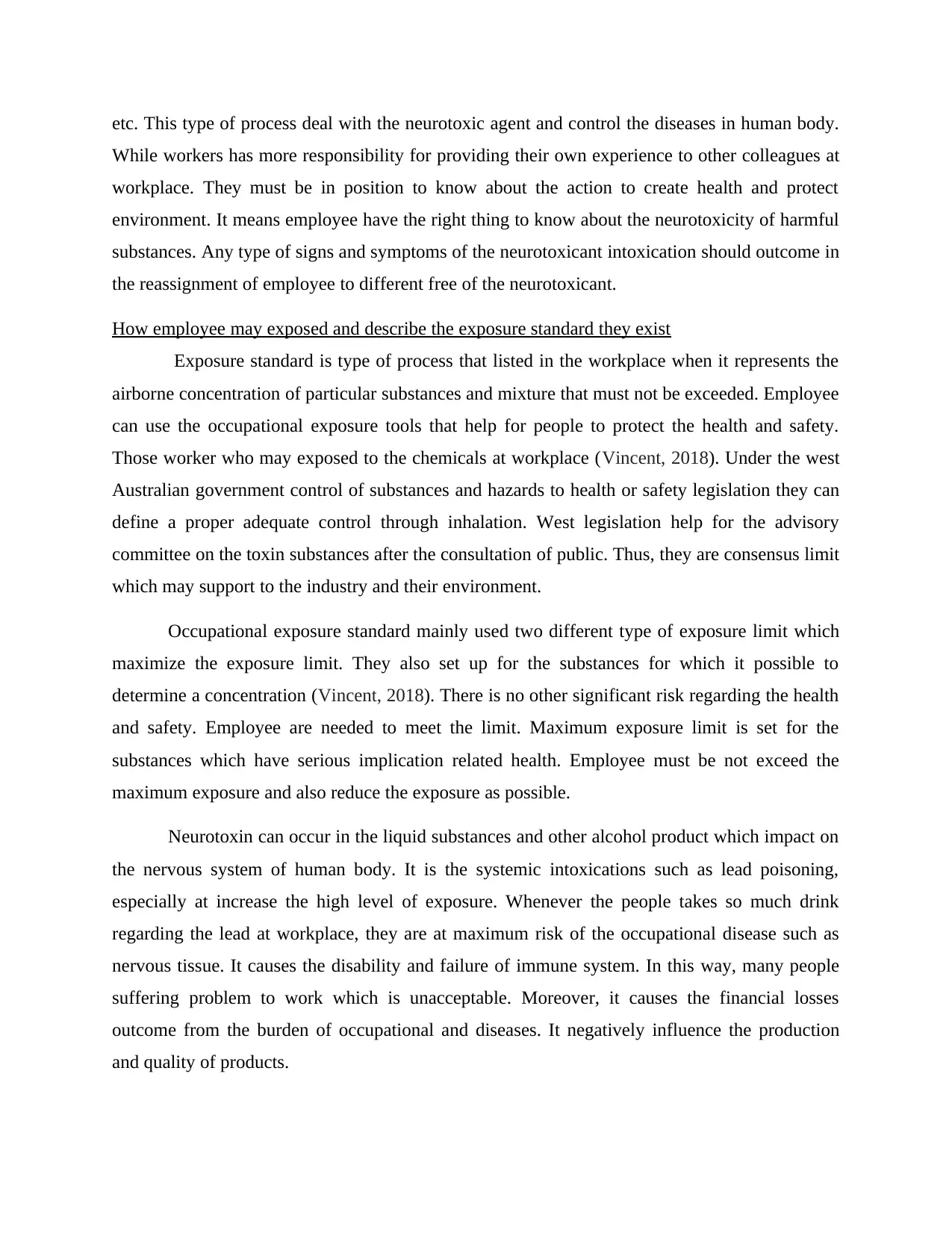
etc. This type of process deal with the neurotoxic agent and control the diseases in human body.
While workers has more responsibility for providing their own experience to other colleagues at
workplace. They must be in position to know about the action to create health and protect
environment. It means employee have the right thing to know about the neurotoxicity of harmful
substances. Any type of signs and symptoms of the neurotoxicant intoxication should outcome in
the reassignment of employee to different free of the neurotoxicant.
How employee may exposed and describe the exposure standard they exist
Exposure standard is type of process that listed in the workplace when it represents the
airborne concentration of particular substances and mixture that must not be exceeded. Employee
can use the occupational exposure tools that help for people to protect the health and safety.
Those worker who may exposed to the chemicals at workplace (Vincent, 2018). Under the west
Australian government control of substances and hazards to health or safety legislation they can
define a proper adequate control through inhalation. West legislation help for the advisory
committee on the toxin substances after the consultation of public. Thus, they are consensus limit
which may support to the industry and their environment.
Occupational exposure standard mainly used two different type of exposure limit which
maximize the exposure limit. They also set up for the substances for which it possible to
determine a concentration (Vincent, 2018). There is no other significant risk regarding the health
and safety. Employee are needed to meet the limit. Maximum exposure limit is set for the
substances which have serious implication related health. Employee must be not exceed the
maximum exposure and also reduce the exposure as possible.
Neurotoxin can occur in the liquid substances and other alcohol product which impact on
the nervous system of human body. It is the systemic intoxications such as lead poisoning,
especially at increase the high level of exposure. Whenever the people takes so much drink
regarding the lead at workplace, they are at maximum risk of the occupational disease such as
nervous tissue. It causes the disability and failure of immune system. In this way, many people
suffering problem to work which is unacceptable. Moreover, it causes the financial losses
outcome from the burden of occupational and diseases. It negatively influence the production
and quality of products.
While workers has more responsibility for providing their own experience to other colleagues at
workplace. They must be in position to know about the action to create health and protect
environment. It means employee have the right thing to know about the neurotoxicity of harmful
substances. Any type of signs and symptoms of the neurotoxicant intoxication should outcome in
the reassignment of employee to different free of the neurotoxicant.
How employee may exposed and describe the exposure standard they exist
Exposure standard is type of process that listed in the workplace when it represents the
airborne concentration of particular substances and mixture that must not be exceeded. Employee
can use the occupational exposure tools that help for people to protect the health and safety.
Those worker who may exposed to the chemicals at workplace (Vincent, 2018). Under the west
Australian government control of substances and hazards to health or safety legislation they can
define a proper adequate control through inhalation. West legislation help for the advisory
committee on the toxin substances after the consultation of public. Thus, they are consensus limit
which may support to the industry and their environment.
Occupational exposure standard mainly used two different type of exposure limit which
maximize the exposure limit. They also set up for the substances for which it possible to
determine a concentration (Vincent, 2018). There is no other significant risk regarding the health
and safety. Employee are needed to meet the limit. Maximum exposure limit is set for the
substances which have serious implication related health. Employee must be not exceed the
maximum exposure and also reduce the exposure as possible.
Neurotoxin can occur in the liquid substances and other alcohol product which impact on
the nervous system of human body. It is the systemic intoxications such as lead poisoning,
especially at increase the high level of exposure. Whenever the people takes so much drink
regarding the lead at workplace, they are at maximum risk of the occupational disease such as
nervous tissue. It causes the disability and failure of immune system. In this way, many people
suffering problem to work which is unacceptable. Moreover, it causes the financial losses
outcome from the burden of occupational and diseases. It negatively influence the production
and quality of products.
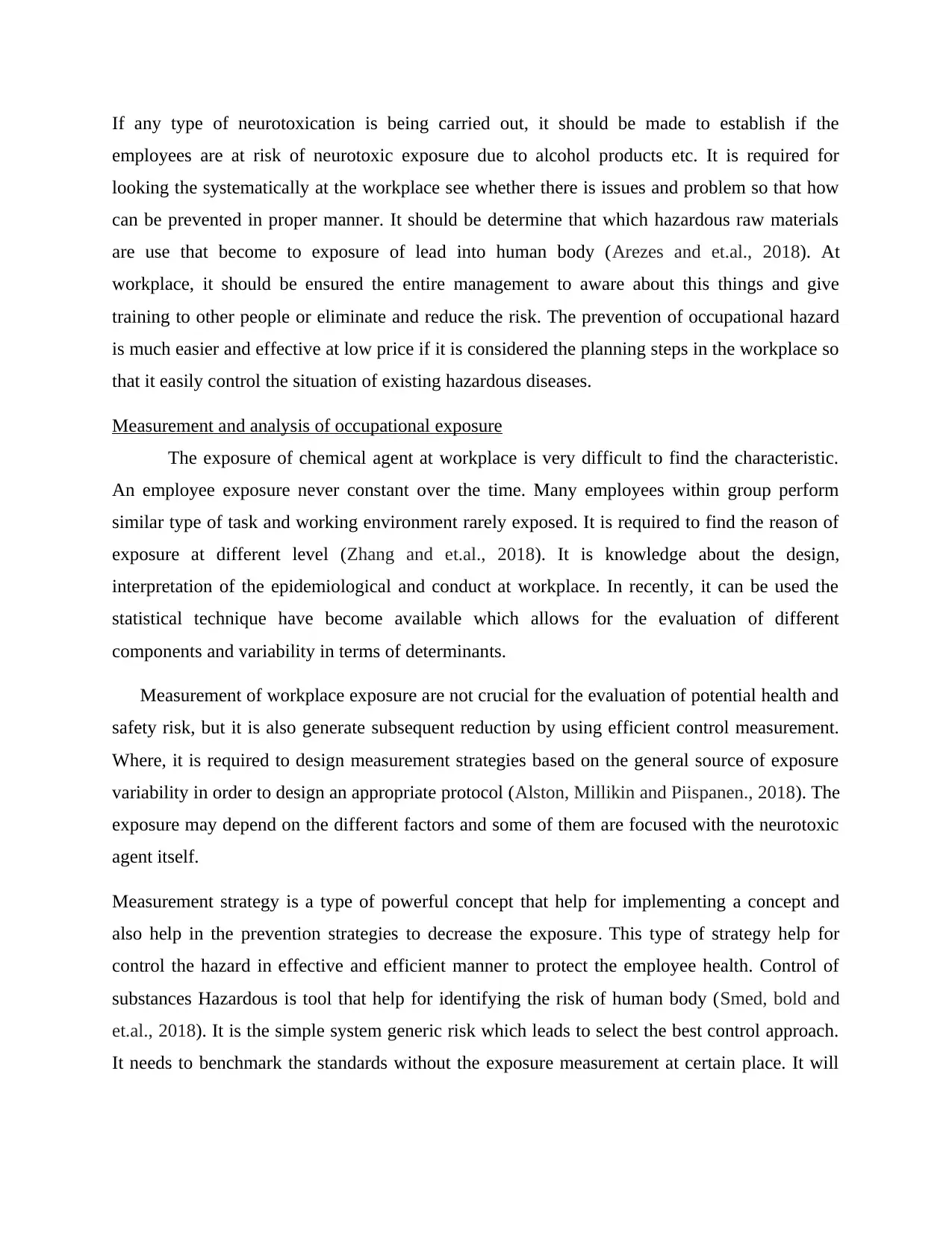
If any type of neurotoxication is being carried out, it should be made to establish if the
employees are at risk of neurotoxic exposure due to alcohol products etc. It is required for
looking the systematically at the workplace see whether there is issues and problem so that how
can be prevented in proper manner. It should be determine that which hazardous raw materials
are use that become to exposure of lead into human body (Arezes and et.al., 2018). At
workplace, it should be ensured the entire management to aware about this things and give
training to other people or eliminate and reduce the risk. The prevention of occupational hazard
is much easier and effective at low price if it is considered the planning steps in the workplace so
that it easily control the situation of existing hazardous diseases.
Measurement and analysis of occupational exposure
The exposure of chemical agent at workplace is very difficult to find the characteristic.
An employee exposure never constant over the time. Many employees within group perform
similar type of task and working environment rarely exposed. It is required to find the reason of
exposure at different level (Zhang and et.al., 2018). It is knowledge about the design,
interpretation of the epidemiological and conduct at workplace. In recently, it can be used the
statistical technique have become available which allows for the evaluation of different
components and variability in terms of determinants.
Measurement of workplace exposure are not crucial for the evaluation of potential health and
safety risk, but it is also generate subsequent reduction by using efficient control measurement.
Where, it is required to design measurement strategies based on the general source of exposure
variability in order to design an appropriate protocol (Alston, Millikin and Piispanen., 2018). The
exposure may depend on the different factors and some of them are focused with the neurotoxic
agent itself.
Measurement strategy is a type of powerful concept that help for implementing a concept and
also help in the prevention strategies to decrease the exposure. This type of strategy help for
control the hazard in effective and efficient manner to protect the employee health. Control of
substances Hazardous is tool that help for identifying the risk of human body (Smed, bold and
et.al., 2018). It is the simple system generic risk which leads to select the best control approach.
It needs to benchmark the standards without the exposure measurement at certain place. It will
employees are at risk of neurotoxic exposure due to alcohol products etc. It is required for
looking the systematically at the workplace see whether there is issues and problem so that how
can be prevented in proper manner. It should be determine that which hazardous raw materials
are use that become to exposure of lead into human body (Arezes and et.al., 2018). At
workplace, it should be ensured the entire management to aware about this things and give
training to other people or eliminate and reduce the risk. The prevention of occupational hazard
is much easier and effective at low price if it is considered the planning steps in the workplace so
that it easily control the situation of existing hazardous diseases.
Measurement and analysis of occupational exposure
The exposure of chemical agent at workplace is very difficult to find the characteristic.
An employee exposure never constant over the time. Many employees within group perform
similar type of task and working environment rarely exposed. It is required to find the reason of
exposure at different level (Zhang and et.al., 2018). It is knowledge about the design,
interpretation of the epidemiological and conduct at workplace. In recently, it can be used the
statistical technique have become available which allows for the evaluation of different
components and variability in terms of determinants.
Measurement of workplace exposure are not crucial for the evaluation of potential health and
safety risk, but it is also generate subsequent reduction by using efficient control measurement.
Where, it is required to design measurement strategies based on the general source of exposure
variability in order to design an appropriate protocol (Alston, Millikin and Piispanen., 2018). The
exposure may depend on the different factors and some of them are focused with the neurotoxic
agent itself.
Measurement strategy is a type of powerful concept that help for implementing a concept and
also help in the prevention strategies to decrease the exposure. This type of strategy help for
control the hazard in effective and efficient manner to protect the employee health. Control of
substances Hazardous is tool that help for identifying the risk of human body (Smed, bold and
et.al., 2018). It is the simple system generic risk which leads to select the best control approach.
It needs to benchmark the standards without the exposure measurement at certain place. It will
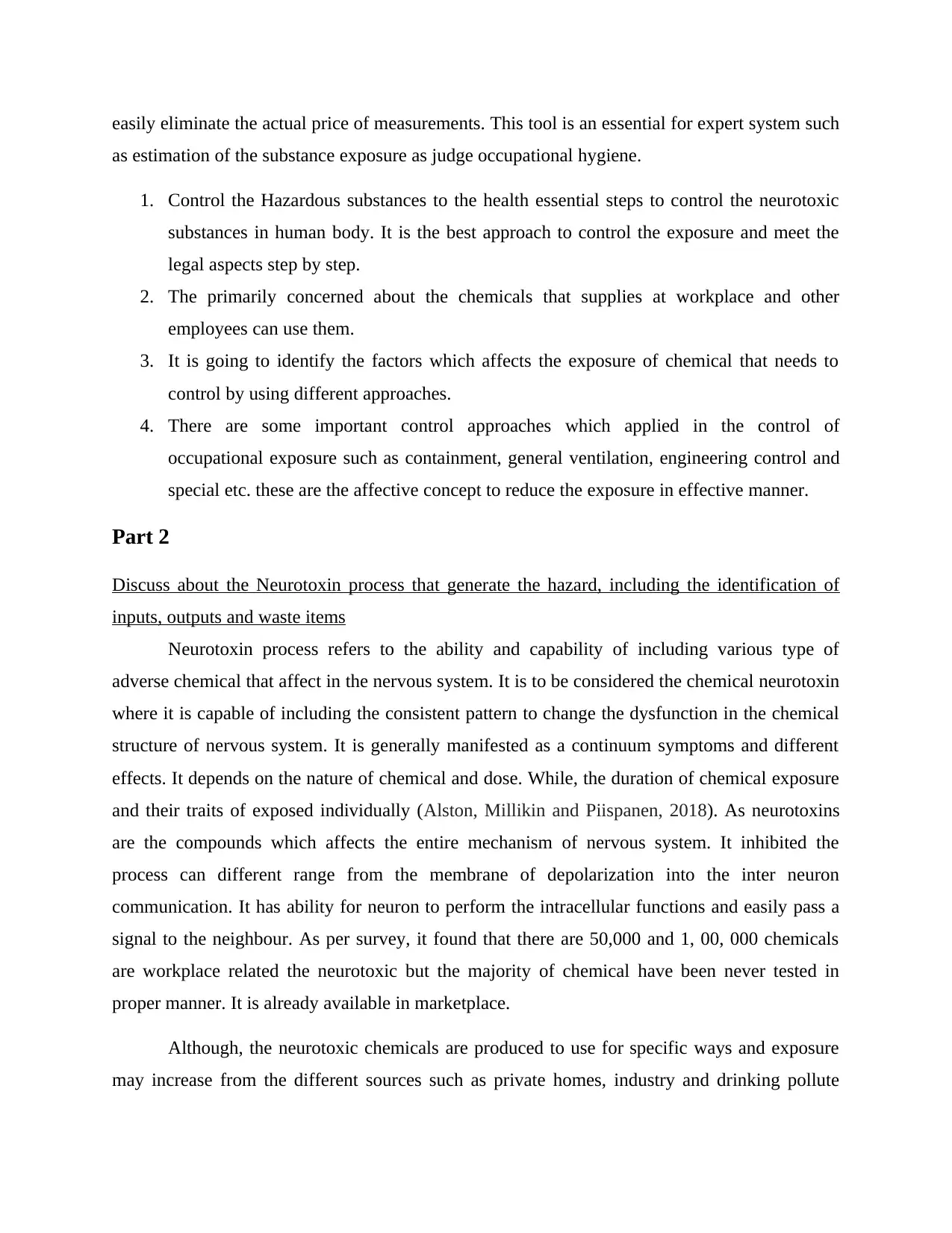
easily eliminate the actual price of measurements. This tool is an essential for expert system such
as estimation of the substance exposure as judge occupational hygiene.
1. Control the Hazardous substances to the health essential steps to control the neurotoxic
substances in human body. It is the best approach to control the exposure and meet the
legal aspects step by step.
2. The primarily concerned about the chemicals that supplies at workplace and other
employees can use them.
3. It is going to identify the factors which affects the exposure of chemical that needs to
control by using different approaches.
4. There are some important control approaches which applied in the control of
occupational exposure such as containment, general ventilation, engineering control and
special etc. these are the affective concept to reduce the exposure in effective manner.
Part 2
Discuss about the Neurotoxin process that generate the hazard, including the identification of
inputs, outputs and waste items
Neurotoxin process refers to the ability and capability of including various type of
adverse chemical that affect in the nervous system. It is to be considered the chemical neurotoxin
where it is capable of including the consistent pattern to change the dysfunction in the chemical
structure of nervous system. It is generally manifested as a continuum symptoms and different
effects. It depends on the nature of chemical and dose. While, the duration of chemical exposure
and their traits of exposed individually (Alston, Millikin and Piispanen, 2018). As neurotoxins
are the compounds which affects the entire mechanism of nervous system. It inhibited the
process can different range from the membrane of depolarization into the inter neuron
communication. It has ability for neuron to perform the intracellular functions and easily pass a
signal to the neighbour. As per survey, it found that there are 50,000 and 1, 00, 000 chemicals
are workplace related the neurotoxic but the majority of chemical have been never tested in
proper manner. It is already available in marketplace.
Although, the neurotoxic chemicals are produced to use for specific ways and exposure
may increase from the different sources such as private homes, industry and drinking pollute
as estimation of the substance exposure as judge occupational hygiene.
1. Control the Hazardous substances to the health essential steps to control the neurotoxic
substances in human body. It is the best approach to control the exposure and meet the
legal aspects step by step.
2. The primarily concerned about the chemicals that supplies at workplace and other
employees can use them.
3. It is going to identify the factors which affects the exposure of chemical that needs to
control by using different approaches.
4. There are some important control approaches which applied in the control of
occupational exposure such as containment, general ventilation, engineering control and
special etc. these are the affective concept to reduce the exposure in effective manner.
Part 2
Discuss about the Neurotoxin process that generate the hazard, including the identification of
inputs, outputs and waste items
Neurotoxin process refers to the ability and capability of including various type of
adverse chemical that affect in the nervous system. It is to be considered the chemical neurotoxin
where it is capable of including the consistent pattern to change the dysfunction in the chemical
structure of nervous system. It is generally manifested as a continuum symptoms and different
effects. It depends on the nature of chemical and dose. While, the duration of chemical exposure
and their traits of exposed individually (Alston, Millikin and Piispanen, 2018). As neurotoxins
are the compounds which affects the entire mechanism of nervous system. It inhibited the
process can different range from the membrane of depolarization into the inter neuron
communication. It has ability for neuron to perform the intracellular functions and easily pass a
signal to the neighbour. As per survey, it found that there are 50,000 and 1, 00, 000 chemicals
are workplace related the neurotoxic but the majority of chemical have been never tested in
proper manner. It is already available in marketplace.
Although, the neurotoxic chemicals are produced to use for specific ways and exposure
may increase from the different sources such as private homes, industry and drinking pollute
Paraphrase This Document
Need a fresh take? Get an instant paraphrase of this document with our AI Paraphraser
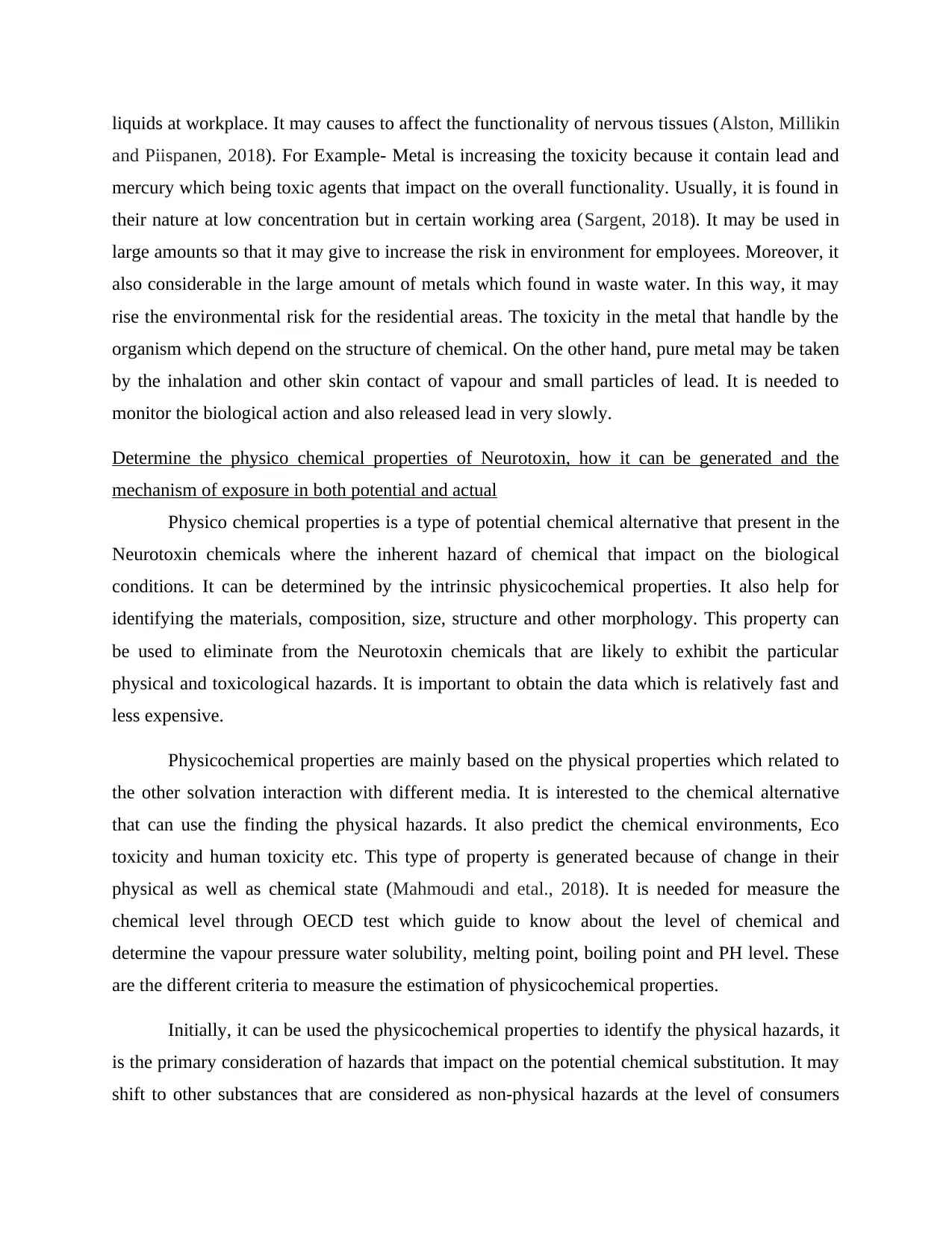
liquids at workplace. It may causes to affect the functionality of nervous tissues (Alston, Millikin
and Piispanen, 2018). For Example- Metal is increasing the toxicity because it contain lead and
mercury which being toxic agents that impact on the overall functionality. Usually, it is found in
their nature at low concentration but in certain working area (Sargent, 2018). It may be used in
large amounts so that it may give to increase the risk in environment for employees. Moreover, it
also considerable in the large amount of metals which found in waste water. In this way, it may
rise the environmental risk for the residential areas. The toxicity in the metal that handle by the
organism which depend on the structure of chemical. On the other hand, pure metal may be taken
by the inhalation and other skin contact of vapour and small particles of lead. It is needed to
monitor the biological action and also released lead in very slowly.
Determine the physico chemical properties of Neurotoxin, how it can be generated and the
mechanism of exposure in both potential and actual
Physico chemical properties is a type of potential chemical alternative that present in the
Neurotoxin chemicals where the inherent hazard of chemical that impact on the biological
conditions. It can be determined by the intrinsic physicochemical properties. It also help for
identifying the materials, composition, size, structure and other morphology. This property can
be used to eliminate from the Neurotoxin chemicals that are likely to exhibit the particular
physical and toxicological hazards. It is important to obtain the data which is relatively fast and
less expensive.
Physicochemical properties are mainly based on the physical properties which related to
the other solvation interaction with different media. It is interested to the chemical alternative
that can use the finding the physical hazards. It also predict the chemical environments, Eco
toxicity and human toxicity etc. This type of property is generated because of change in their
physical as well as chemical state (Mahmoudi and etal., 2018). It is needed for measure the
chemical level through OECD test which guide to know about the level of chemical and
determine the vapour pressure water solubility, melting point, boiling point and PH level. These
are the different criteria to measure the estimation of physicochemical properties.
Initially, it can be used the physicochemical properties to identify the physical hazards, it
is the primary consideration of hazards that impact on the potential chemical substitution. It may
shift to other substances that are considered as non-physical hazards at the level of consumers
and Piispanen, 2018). For Example- Metal is increasing the toxicity because it contain lead and
mercury which being toxic agents that impact on the overall functionality. Usually, it is found in
their nature at low concentration but in certain working area (Sargent, 2018). It may be used in
large amounts so that it may give to increase the risk in environment for employees. Moreover, it
also considerable in the large amount of metals which found in waste water. In this way, it may
rise the environmental risk for the residential areas. The toxicity in the metal that handle by the
organism which depend on the structure of chemical. On the other hand, pure metal may be taken
by the inhalation and other skin contact of vapour and small particles of lead. It is needed to
monitor the biological action and also released lead in very slowly.
Determine the physico chemical properties of Neurotoxin, how it can be generated and the
mechanism of exposure in both potential and actual
Physico chemical properties is a type of potential chemical alternative that present in the
Neurotoxin chemicals where the inherent hazard of chemical that impact on the biological
conditions. It can be determined by the intrinsic physicochemical properties. It also help for
identifying the materials, composition, size, structure and other morphology. This property can
be used to eliminate from the Neurotoxin chemicals that are likely to exhibit the particular
physical and toxicological hazards. It is important to obtain the data which is relatively fast and
less expensive.
Physicochemical properties are mainly based on the physical properties which related to
the other solvation interaction with different media. It is interested to the chemical alternative
that can use the finding the physical hazards. It also predict the chemical environments, Eco
toxicity and human toxicity etc. This type of property is generated because of change in their
physical as well as chemical state (Mahmoudi and etal., 2018). It is needed for measure the
chemical level through OECD test which guide to know about the level of chemical and
determine the vapour pressure water solubility, melting point, boiling point and PH level. These
are the different criteria to measure the estimation of physicochemical properties.
Initially, it can be used the physicochemical properties to identify the physical hazards, it
is the primary consideration of hazards that impact on the potential chemical substitution. It may
shift to other substances that are considered as non-physical hazards at the level of consumers
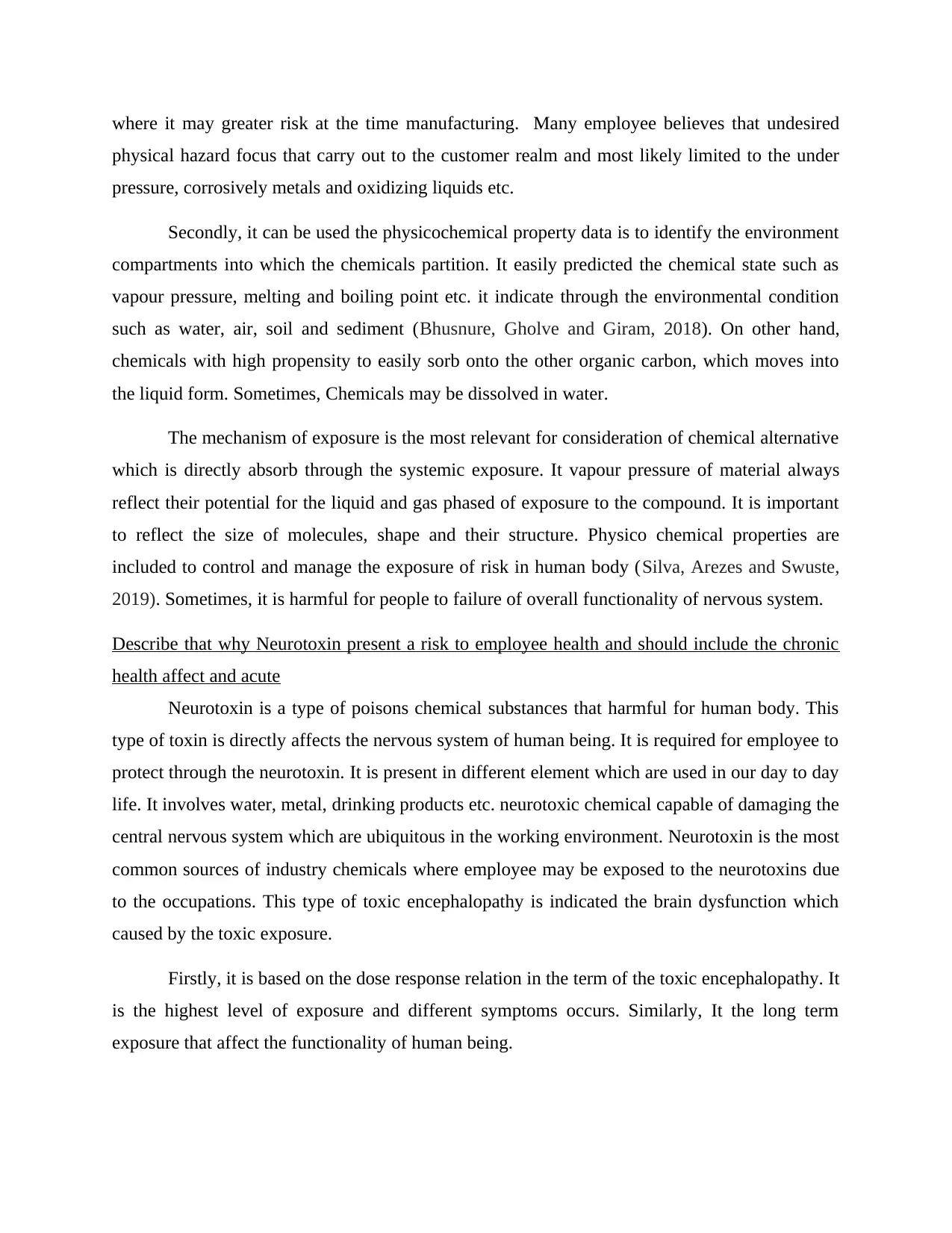
where it may greater risk at the time manufacturing. Many employee believes that undesired
physical hazard focus that carry out to the customer realm and most likely limited to the under
pressure, corrosively metals and oxidizing liquids etc.
Secondly, it can be used the physicochemical property data is to identify the environment
compartments into which the chemicals partition. It easily predicted the chemical state such as
vapour pressure, melting and boiling point etc. it indicate through the environmental condition
such as water, air, soil and sediment (Bhusnure, Gholve and Giram, 2018). On other hand,
chemicals with high propensity to easily sorb onto the other organic carbon, which moves into
the liquid form. Sometimes, Chemicals may be dissolved in water.
The mechanism of exposure is the most relevant for consideration of chemical alternative
which is directly absorb through the systemic exposure. It vapour pressure of material always
reflect their potential for the liquid and gas phased of exposure to the compound. It is important
to reflect the size of molecules, shape and their structure. Physico chemical properties are
included to control and manage the exposure of risk in human body (Silva, Arezes and Swuste,
2019). Sometimes, it is harmful for people to failure of overall functionality of nervous system.
Describe that why Neurotoxin present a risk to employee health and should include the chronic
health affect and acute
Neurotoxin is a type of poisons chemical substances that harmful for human body. This
type of toxin is directly affects the nervous system of human being. It is required for employee to
protect through the neurotoxin. It is present in different element which are used in our day to day
life. It involves water, metal, drinking products etc. neurotoxic chemical capable of damaging the
central nervous system which are ubiquitous in the working environment. Neurotoxin is the most
common sources of industry chemicals where employee may be exposed to the neurotoxins due
to the occupations. This type of toxic encephalopathy is indicated the brain dysfunction which
caused by the toxic exposure.
Firstly, it is based on the dose response relation in the term of the toxic encephalopathy. It
is the highest level of exposure and different symptoms occurs. Similarly, It the long term
exposure that affect the functionality of human being.
physical hazard focus that carry out to the customer realm and most likely limited to the under
pressure, corrosively metals and oxidizing liquids etc.
Secondly, it can be used the physicochemical property data is to identify the environment
compartments into which the chemicals partition. It easily predicted the chemical state such as
vapour pressure, melting and boiling point etc. it indicate through the environmental condition
such as water, air, soil and sediment (Bhusnure, Gholve and Giram, 2018). On other hand,
chemicals with high propensity to easily sorb onto the other organic carbon, which moves into
the liquid form. Sometimes, Chemicals may be dissolved in water.
The mechanism of exposure is the most relevant for consideration of chemical alternative
which is directly absorb through the systemic exposure. It vapour pressure of material always
reflect their potential for the liquid and gas phased of exposure to the compound. It is important
to reflect the size of molecules, shape and their structure. Physico chemical properties are
included to control and manage the exposure of risk in human body (Silva, Arezes and Swuste,
2019). Sometimes, it is harmful for people to failure of overall functionality of nervous system.
Describe that why Neurotoxin present a risk to employee health and should include the chronic
health affect and acute
Neurotoxin is a type of poisons chemical substances that harmful for human body. This
type of toxin is directly affects the nervous system of human being. It is required for employee to
protect through the neurotoxin. It is present in different element which are used in our day to day
life. It involves water, metal, drinking products etc. neurotoxic chemical capable of damaging the
central nervous system which are ubiquitous in the working environment. Neurotoxin is the most
common sources of industry chemicals where employee may be exposed to the neurotoxins due
to the occupations. This type of toxic encephalopathy is indicated the brain dysfunction which
caused by the toxic exposure.
Firstly, it is based on the dose response relation in the term of the toxic encephalopathy. It
is the highest level of exposure and different symptoms occurs. Similarly, It the long term
exposure that affect the functionality of human being.
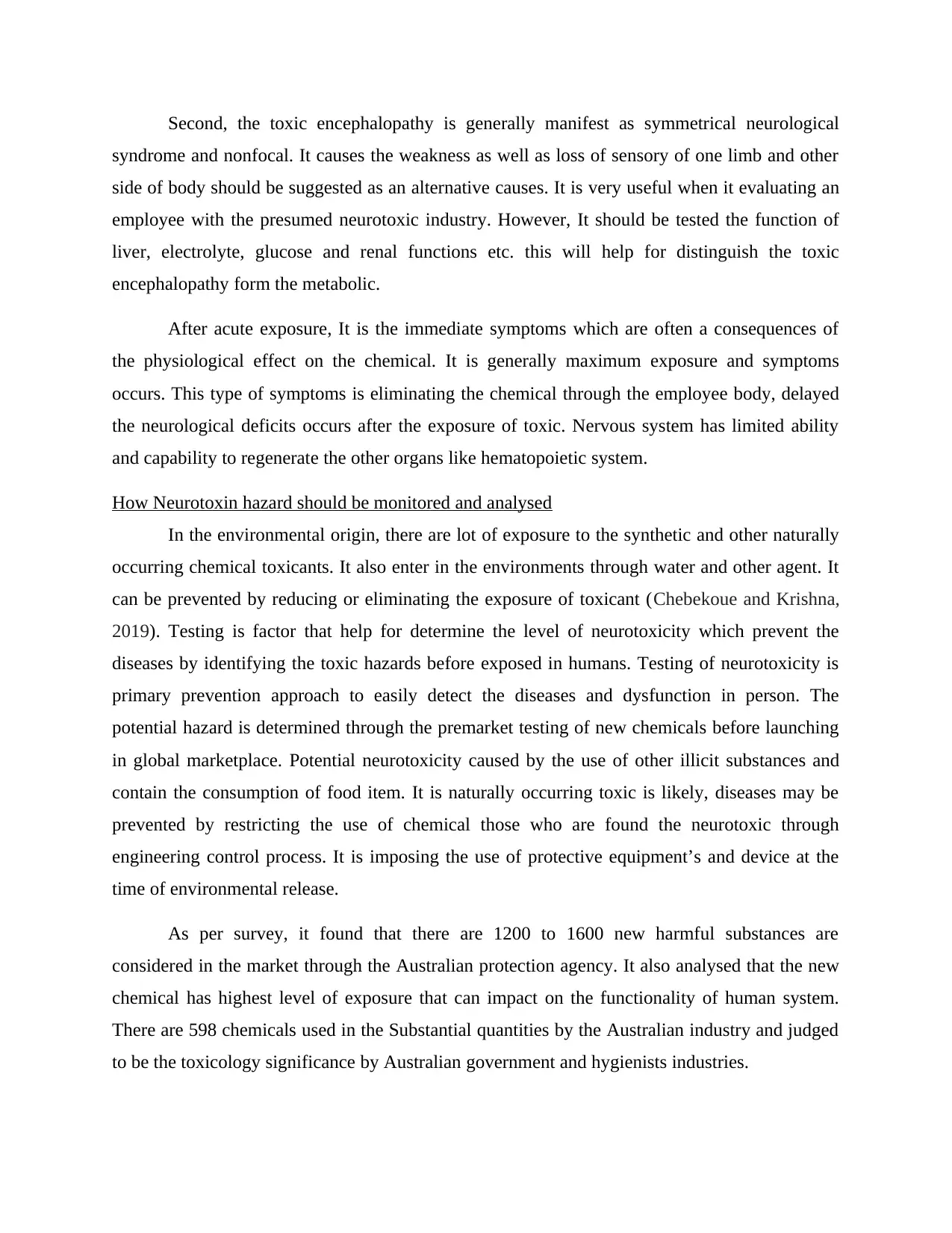
Second, the toxic encephalopathy is generally manifest as symmetrical neurological
syndrome and nonfocal. It causes the weakness as well as loss of sensory of one limb and other
side of body should be suggested as an alternative causes. It is very useful when it evaluating an
employee with the presumed neurotoxic industry. However, It should be tested the function of
liver, electrolyte, glucose and renal functions etc. this will help for distinguish the toxic
encephalopathy form the metabolic.
After acute exposure, It is the immediate symptoms which are often a consequences of
the physiological effect on the chemical. It is generally maximum exposure and symptoms
occurs. This type of symptoms is eliminating the chemical through the employee body, delayed
the neurological deficits occurs after the exposure of toxic. Nervous system has limited ability
and capability to regenerate the other organs like hematopoietic system.
How Neurotoxin hazard should be monitored and analysed
In the environmental origin, there are lot of exposure to the synthetic and other naturally
occurring chemical toxicants. It also enter in the environments through water and other agent. It
can be prevented by reducing or eliminating the exposure of toxicant (Chebekoue and Krishna,
2019). Testing is factor that help for determine the level of neurotoxicity which prevent the
diseases by identifying the toxic hazards before exposed in humans. Testing of neurotoxicity is
primary prevention approach to easily detect the diseases and dysfunction in person. The
potential hazard is determined through the premarket testing of new chemicals before launching
in global marketplace. Potential neurotoxicity caused by the use of other illicit substances and
contain the consumption of food item. It is naturally occurring toxic is likely, diseases may be
prevented by restricting the use of chemical those who are found the neurotoxic through
engineering control process. It is imposing the use of protective equipment’s and device at the
time of environmental release.
As per survey, it found that there are 1200 to 1600 new harmful substances are
considered in the market through the Australian protection agency. It also analysed that the new
chemical has highest level of exposure that can impact on the functionality of human system.
There are 598 chemicals used in the Substantial quantities by the Australian industry and judged
to be the toxicology significance by Australian government and hygienists industries.
syndrome and nonfocal. It causes the weakness as well as loss of sensory of one limb and other
side of body should be suggested as an alternative causes. It is very useful when it evaluating an
employee with the presumed neurotoxic industry. However, It should be tested the function of
liver, electrolyte, glucose and renal functions etc. this will help for distinguish the toxic
encephalopathy form the metabolic.
After acute exposure, It is the immediate symptoms which are often a consequences of
the physiological effect on the chemical. It is generally maximum exposure and symptoms
occurs. This type of symptoms is eliminating the chemical through the employee body, delayed
the neurological deficits occurs after the exposure of toxic. Nervous system has limited ability
and capability to regenerate the other organs like hematopoietic system.
How Neurotoxin hazard should be monitored and analysed
In the environmental origin, there are lot of exposure to the synthetic and other naturally
occurring chemical toxicants. It also enter in the environments through water and other agent. It
can be prevented by reducing or eliminating the exposure of toxicant (Chebekoue and Krishna,
2019). Testing is factor that help for determine the level of neurotoxicity which prevent the
diseases by identifying the toxic hazards before exposed in humans. Testing of neurotoxicity is
primary prevention approach to easily detect the diseases and dysfunction in person. The
potential hazard is determined through the premarket testing of new chemicals before launching
in global marketplace. Potential neurotoxicity caused by the use of other illicit substances and
contain the consumption of food item. It is naturally occurring toxic is likely, diseases may be
prevented by restricting the use of chemical those who are found the neurotoxic through
engineering control process. It is imposing the use of protective equipment’s and device at the
time of environmental release.
As per survey, it found that there are 1200 to 1600 new harmful substances are
considered in the market through the Australian protection agency. It also analysed that the new
chemical has highest level of exposure that can impact on the functionality of human system.
There are 598 chemicals used in the Substantial quantities by the Australian industry and judged
to be the toxicology significance by Australian government and hygienists industries.
Secure Best Marks with AI Grader
Need help grading? Try our AI Grader for instant feedback on your assignments.

Neurodiagnostic technique is a type of approach that support to analyse and monitor the
hazardous toxic. It deficits to determine the exposure to the toxicants such as memory, problem
solving and disturbances in the intelligence etc. It easily detect the effects in the overall human
body. This technique is described the symptoms which usually occurs. It is clearly noticed by the
employee and other people (Silva, Arezes and Swuste., 2019). It is based on the evaluation by
using standard tests, which follows the specific procedure capable of providing the quantifiable
results and outcomes. This process has analysed and monitor the chemical toxic and other
harmful substances. It is apparent that technique currently applicable in the neurotoxicity
screening program. It also more effective process to target the specific functionality of
vulnerability to neurotoxin.
Explain the specific standards, code of practices and method applicable in the exposure.
At workplace, the exposure standard in west Australia cover approximately 700
chemicals. A workplace exposure standard for the particular chemical set an appropriate legal
concentration limit that must not be exceeded in properly (Silva, Arezes and Swuste, 2019). It is
simply the maximum upper limits that prescribed by the proper rules and regulations. Everyone
has different that some might experience of adverse health issues below the standard exposure.
There are some specific exposure standard to ensure the high quality evidence or supported by
the government.
Public Consultation-
In 2015, public consultation process held to determine the role of standard exposure at workplace
and how it can be maintained or reviewed. It is based on the regulatory standards to manage the
entire frame work of global industries. It is also recommended to change the level of exposure
standards at workplace. It is beneficial with the association in terms of cost with any changes.
Preliminary evaluation-
In 2016, it undertaken the preliminary evaluation of Australia workplace exposure standards for
airborne contaminants. It is provided an idea and indication of standard that may require to
update. The toxicological knowledge and recommendations for the harmful toxic hazardous
chemicals (Hashimoto and et.al., 2018). It is also used the evaluation process to review and
hazardous toxic. It deficits to determine the exposure to the toxicants such as memory, problem
solving and disturbances in the intelligence etc. It easily detect the effects in the overall human
body. This technique is described the symptoms which usually occurs. It is clearly noticed by the
employee and other people (Silva, Arezes and Swuste., 2019). It is based on the evaluation by
using standard tests, which follows the specific procedure capable of providing the quantifiable
results and outcomes. This process has analysed and monitor the chemical toxic and other
harmful substances. It is apparent that technique currently applicable in the neurotoxicity
screening program. It also more effective process to target the specific functionality of
vulnerability to neurotoxin.
Explain the specific standards, code of practices and method applicable in the exposure.
At workplace, the exposure standard in west Australia cover approximately 700
chemicals. A workplace exposure standard for the particular chemical set an appropriate legal
concentration limit that must not be exceeded in properly (Silva, Arezes and Swuste, 2019). It is
simply the maximum upper limits that prescribed by the proper rules and regulations. Everyone
has different that some might experience of adverse health issues below the standard exposure.
There are some specific exposure standard to ensure the high quality evidence or supported by
the government.
Public Consultation-
In 2015, public consultation process held to determine the role of standard exposure at workplace
and how it can be maintained or reviewed. It is based on the regulatory standards to manage the
entire frame work of global industries. It is also recommended to change the level of exposure
standards at workplace. It is beneficial with the association in terms of cost with any changes.
Preliminary evaluation-
In 2016, it undertaken the preliminary evaluation of Australia workplace exposure standards for
airborne contaminants. It is provided an idea and indication of standard that may require to
update. The toxicological knowledge and recommendations for the harmful toxic hazardous
chemicals (Hashimoto and et.al., 2018). It is also used the evaluation process to review and

identify the workplace standard exposure. It might be timely, applicable in the Australia
contemporary and also adopt the advanced knowledge of toxicological.
Code of Practices-
Code of practices is basically prepared documentation which provide by the practical guidance
on how to manage and comply the specific duty under the western Australian occupational health
or safety law.
Control and Safe use of in organic lead at workplace-
This law was conducted by the western Australian government so that many companies are
followed this rules where they can manufacture the products and after testing. The regulation is
described the requirement for workplace in which the hazardous materials like leads. It may
causes the human health. In this way, employee can use the legal obligation to meet the safe
working environment and culture.
Control of workplace Hazardous Substances –
This law was conducted by the western Australian government which requires for organizations
to maintain the business aspects in proper manner. The objective of this legislation for control of
workplace hazardous substances to reduce the risk of adverse health effect because of the
exposure to the hazardous substances at workplace. As per legislation, many industries are
applied the regulation for managing and controlling the hazardous substances in proper manner.
Labelling of workplace Substances-
It is national code of practices for the labelling of workplace substances that provide a flexible
system of the company to use the proper labelling in their products. In this way, importers can
meet the need under the circumstances (Chang and et.al., 2019). As per regulation, it applies a
proper labelling and at the same time, it may produce the label to the workplace requirements.
Occupational Safety and health in call centres-
This legislation is important in Australia because it help for call centres provide the equal right to
their employee. It is required to comply with this regulation of the employee work in call centre.
It applies to the employees and employers. Call centre is a type of workplace where the main
contemporary and also adopt the advanced knowledge of toxicological.
Code of Practices-
Code of practices is basically prepared documentation which provide by the practical guidance
on how to manage and comply the specific duty under the western Australian occupational health
or safety law.
Control and Safe use of in organic lead at workplace-
This law was conducted by the western Australian government so that many companies are
followed this rules where they can manufacture the products and after testing. The regulation is
described the requirement for workplace in which the hazardous materials like leads. It may
causes the human health. In this way, employee can use the legal obligation to meet the safe
working environment and culture.
Control of workplace Hazardous Substances –
This law was conducted by the western Australian government which requires for organizations
to maintain the business aspects in proper manner. The objective of this legislation for control of
workplace hazardous substances to reduce the risk of adverse health effect because of the
exposure to the hazardous substances at workplace. As per legislation, many industries are
applied the regulation for managing and controlling the hazardous substances in proper manner.
Labelling of workplace Substances-
It is national code of practices for the labelling of workplace substances that provide a flexible
system of the company to use the proper labelling in their products. In this way, importers can
meet the need under the circumstances (Chang and et.al., 2019). As per regulation, it applies a
proper labelling and at the same time, it may produce the label to the workplace requirements.
Occupational Safety and health in call centres-
This legislation is important in Australia because it help for call centres provide the equal right to
their employee. It is required to comply with this regulation of the employee work in call centre.
It applies to the employees and employers. Call centre is a type of workplace where the main
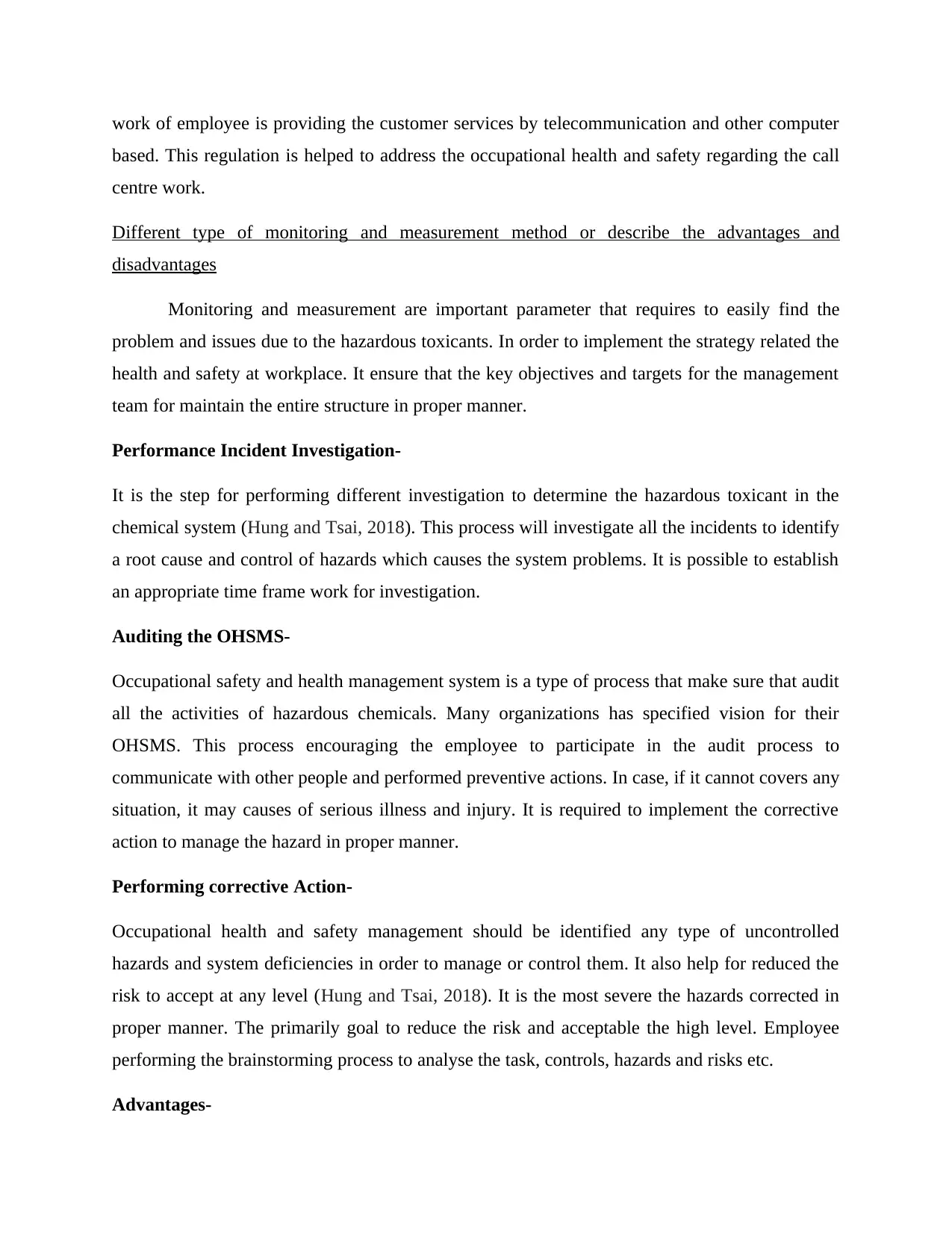
work of employee is providing the customer services by telecommunication and other computer
based. This regulation is helped to address the occupational health and safety regarding the call
centre work.
Different type of monitoring and measurement method or describe the advantages and
disadvantages
Monitoring and measurement are important parameter that requires to easily find the
problem and issues due to the hazardous toxicants. In order to implement the strategy related the
health and safety at workplace. It ensure that the key objectives and targets for the management
team for maintain the entire structure in proper manner.
Performance Incident Investigation-
It is the step for performing different investigation to determine the hazardous toxicant in the
chemical system (Hung and Tsai, 2018). This process will investigate all the incidents to identify
a root cause and control of hazards which causes the system problems. It is possible to establish
an appropriate time frame work for investigation.
Auditing the OHSMS-
Occupational safety and health management system is a type of process that make sure that audit
all the activities of hazardous chemicals. Many organizations has specified vision for their
OHSMS. This process encouraging the employee to participate in the audit process to
communicate with other people and performed preventive actions. In case, if it cannot covers any
situation, it may causes of serious illness and injury. It is required to implement the corrective
action to manage the hazard in proper manner.
Performing corrective Action-
Occupational health and safety management should be identified any type of uncontrolled
hazards and system deficiencies in order to manage or control them. It also help for reduced the
risk to accept at any level (Hung and Tsai, 2018). It is the most severe the hazards corrected in
proper manner. The primarily goal to reduce the risk and acceptable the high level. Employee
performing the brainstorming process to analyse the task, controls, hazards and risks etc.
Advantages-
based. This regulation is helped to address the occupational health and safety regarding the call
centre work.
Different type of monitoring and measurement method or describe the advantages and
disadvantages
Monitoring and measurement are important parameter that requires to easily find the
problem and issues due to the hazardous toxicants. In order to implement the strategy related the
health and safety at workplace. It ensure that the key objectives and targets for the management
team for maintain the entire structure in proper manner.
Performance Incident Investigation-
It is the step for performing different investigation to determine the hazardous toxicant in the
chemical system (Hung and Tsai, 2018). This process will investigate all the incidents to identify
a root cause and control of hazards which causes the system problems. It is possible to establish
an appropriate time frame work for investigation.
Auditing the OHSMS-
Occupational safety and health management system is a type of process that make sure that audit
all the activities of hazardous chemicals. Many organizations has specified vision for their
OHSMS. This process encouraging the employee to participate in the audit process to
communicate with other people and performed preventive actions. In case, if it cannot covers any
situation, it may causes of serious illness and injury. It is required to implement the corrective
action to manage the hazard in proper manner.
Performing corrective Action-
Occupational health and safety management should be identified any type of uncontrolled
hazards and system deficiencies in order to manage or control them. It also help for reduced the
risk to accept at any level (Hung and Tsai, 2018). It is the most severe the hazards corrected in
proper manner. The primarily goal to reduce the risk and acceptable the high level. Employee
performing the brainstorming process to analyse the task, controls, hazards and risks etc.
Advantages-
Paraphrase This Document
Need a fresh take? Get an instant paraphrase of this document with our AI Paraphraser

It should be used the compatible equipment and analytical method for the purpose of
validation. It is suitable range of concentration above the limit of exposure.
Static Monitoring should be applicable for identifying the distribution of chemical and
maintain the working environment. In case any problem, it easily detect the high
exposure of hazardous chemical.
Personal monitoring should be used evaluating the risk of exposure through the
individual employee.
Measurement technique is mainly used to measure exposure which allow for employee to
work in night shift. The exposure should be compared to the other occupational exposure
limit and their values (Hung and Tsai, 2018). The measurement may be continuous over
the night shift and as long as possible. In this way, it help for employee to calculate the
overall estimation of exposure level.
Disadvantages-
Personal measurement process is based on the employee where how they can implement
the concept for the investigation of hazardous chemicals and toxicants in the functionality
of system.
It is required for employee to provide training to understand the situation and condition
regarding health or safety.
Sometimes, it is very difficult for analysing and identifying the problem as a root of cause
in the illness. (Hung and Tsai, 2018).
It is required for risk adjustment a larger sample needs but it has generated many
outcome for long terms observations. It is difficult to adjust the risk and requires the
different type of model for generation of outcomes.
validation. It is suitable range of concentration above the limit of exposure.
Static Monitoring should be applicable for identifying the distribution of chemical and
maintain the working environment. In case any problem, it easily detect the high
exposure of hazardous chemical.
Personal monitoring should be used evaluating the risk of exposure through the
individual employee.
Measurement technique is mainly used to measure exposure which allow for employee to
work in night shift. The exposure should be compared to the other occupational exposure
limit and their values (Hung and Tsai, 2018). The measurement may be continuous over
the night shift and as long as possible. In this way, it help for employee to calculate the
overall estimation of exposure level.
Disadvantages-
Personal measurement process is based on the employee where how they can implement
the concept for the investigation of hazardous chemicals and toxicants in the functionality
of system.
It is required for employee to provide training to understand the situation and condition
regarding health or safety.
Sometimes, it is very difficult for analysing and identifying the problem as a root of cause
in the illness. (Hung and Tsai, 2018).
It is required for risk adjustment a larger sample needs but it has generated many
outcome for long terms observations. It is difficult to adjust the risk and requires the
different type of model for generation of outcomes.
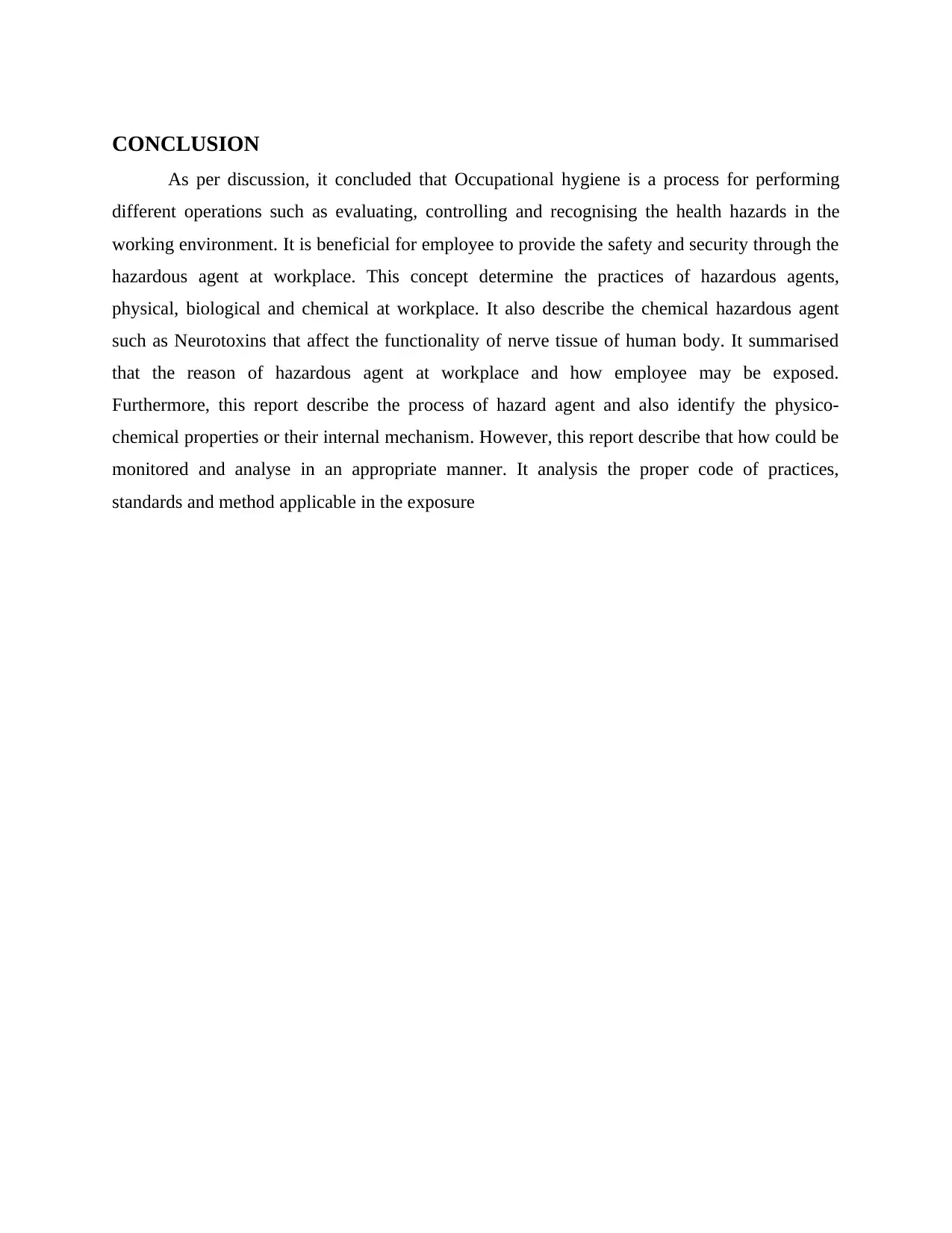
CONCLUSION
As per discussion, it concluded that Occupational hygiene is a process for performing
different operations such as evaluating, controlling and recognising the health hazards in the
working environment. It is beneficial for employee to provide the safety and security through the
hazardous agent at workplace. This concept determine the practices of hazardous agents,
physical, biological and chemical at workplace. It also describe the chemical hazardous agent
such as Neurotoxins that affect the functionality of nerve tissue of human body. It summarised
that the reason of hazardous agent at workplace and how employee may be exposed.
Furthermore, this report describe the process of hazard agent and also identify the physico-
chemical properties or their internal mechanism. However, this report describe that how could be
monitored and analyse in an appropriate manner. It analysis the proper code of practices,
standards and method applicable in the exposure
As per discussion, it concluded that Occupational hygiene is a process for performing
different operations such as evaluating, controlling and recognising the health hazards in the
working environment. It is beneficial for employee to provide the safety and security through the
hazardous agent at workplace. This concept determine the practices of hazardous agents,
physical, biological and chemical at workplace. It also describe the chemical hazardous agent
such as Neurotoxins that affect the functionality of nerve tissue of human body. It summarised
that the reason of hazardous agent at workplace and how employee may be exposed.
Furthermore, this report describe the process of hazard agent and also identify the physico-
chemical properties or their internal mechanism. However, this report describe that how could be
monitored and analyse in an appropriate manner. It analysis the proper code of practices,
standards and method applicable in the exposure
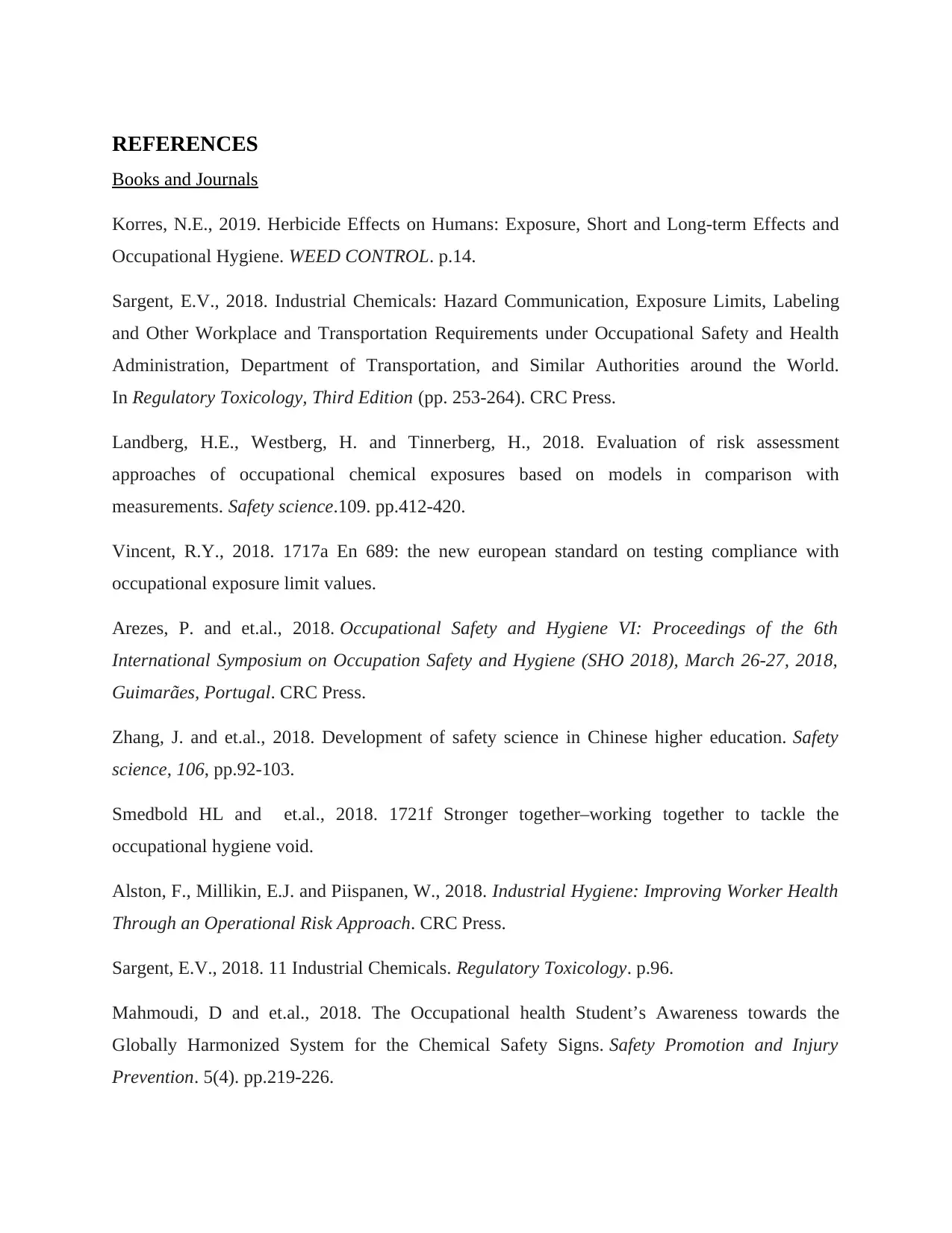
REFERENCES
Books and Journals
Korres, N.E., 2019. Herbicide Effects on Humans: Exposure, Short and Long-term Effects and
Occupational Hygiene. WEED CONTROL. p.14.
Sargent, E.V., 2018. Industrial Chemicals: Hazard Communication, Exposure Limits, Labeling
and Other Workplace and Transportation Requirements under Occupational Safety and Health
Administration, Department of Transportation, and Similar Authorities around the World.
In Regulatory Toxicology, Third Edition (pp. 253-264). CRC Press.
Landberg, H.E., Westberg, H. and Tinnerberg, H., 2018. Evaluation of risk assessment
approaches of occupational chemical exposures based on models in comparison with
measurements. Safety science.109. pp.412-420.
Vincent, R.Y., 2018. 1717a En 689: the new european standard on testing compliance with
occupational exposure limit values.
Arezes, P. and et.al., 2018. Occupational Safety and Hygiene VI: Proceedings of the 6th
International Symposium on Occupation Safety and Hygiene (SHO 2018), March 26-27, 2018,
Guimarães, Portugal. CRC Press.
Zhang, J. and et.al., 2018. Development of safety science in Chinese higher education. Safety
science, 106, pp.92-103.
Smedbold HL and et.al., 2018. 1721f Stronger together–working together to tackle the
occupational hygiene void.
Alston, F., Millikin, E.J. and Piispanen, W., 2018. Industrial Hygiene: Improving Worker Health
Through an Operational Risk Approach. CRC Press.
Sargent, E.V., 2018. 11 Industrial Chemicals. Regulatory Toxicology. p.96.
Mahmoudi, D and et.al., 2018. The Occupational health Student’s Awareness towards the
Globally Harmonized System for the Chemical Safety Signs. Safety Promotion and Injury
Prevention. 5(4). pp.219-226.
Books and Journals
Korres, N.E., 2019. Herbicide Effects on Humans: Exposure, Short and Long-term Effects and
Occupational Hygiene. WEED CONTROL. p.14.
Sargent, E.V., 2018. Industrial Chemicals: Hazard Communication, Exposure Limits, Labeling
and Other Workplace and Transportation Requirements under Occupational Safety and Health
Administration, Department of Transportation, and Similar Authorities around the World.
In Regulatory Toxicology, Third Edition (pp. 253-264). CRC Press.
Landberg, H.E., Westberg, H. and Tinnerberg, H., 2018. Evaluation of risk assessment
approaches of occupational chemical exposures based on models in comparison with
measurements. Safety science.109. pp.412-420.
Vincent, R.Y., 2018. 1717a En 689: the new european standard on testing compliance with
occupational exposure limit values.
Arezes, P. and et.al., 2018. Occupational Safety and Hygiene VI: Proceedings of the 6th
International Symposium on Occupation Safety and Hygiene (SHO 2018), March 26-27, 2018,
Guimarães, Portugal. CRC Press.
Zhang, J. and et.al., 2018. Development of safety science in Chinese higher education. Safety
science, 106, pp.92-103.
Smedbold HL and et.al., 2018. 1721f Stronger together–working together to tackle the
occupational hygiene void.
Alston, F., Millikin, E.J. and Piispanen, W., 2018. Industrial Hygiene: Improving Worker Health
Through an Operational Risk Approach. CRC Press.
Sargent, E.V., 2018. 11 Industrial Chemicals. Regulatory Toxicology. p.96.
Mahmoudi, D and et.al., 2018. The Occupational health Student’s Awareness towards the
Globally Harmonized System for the Chemical Safety Signs. Safety Promotion and Injury
Prevention. 5(4). pp.219-226.
Secure Best Marks with AI Grader
Need help grading? Try our AI Grader for instant feedback on your assignments.
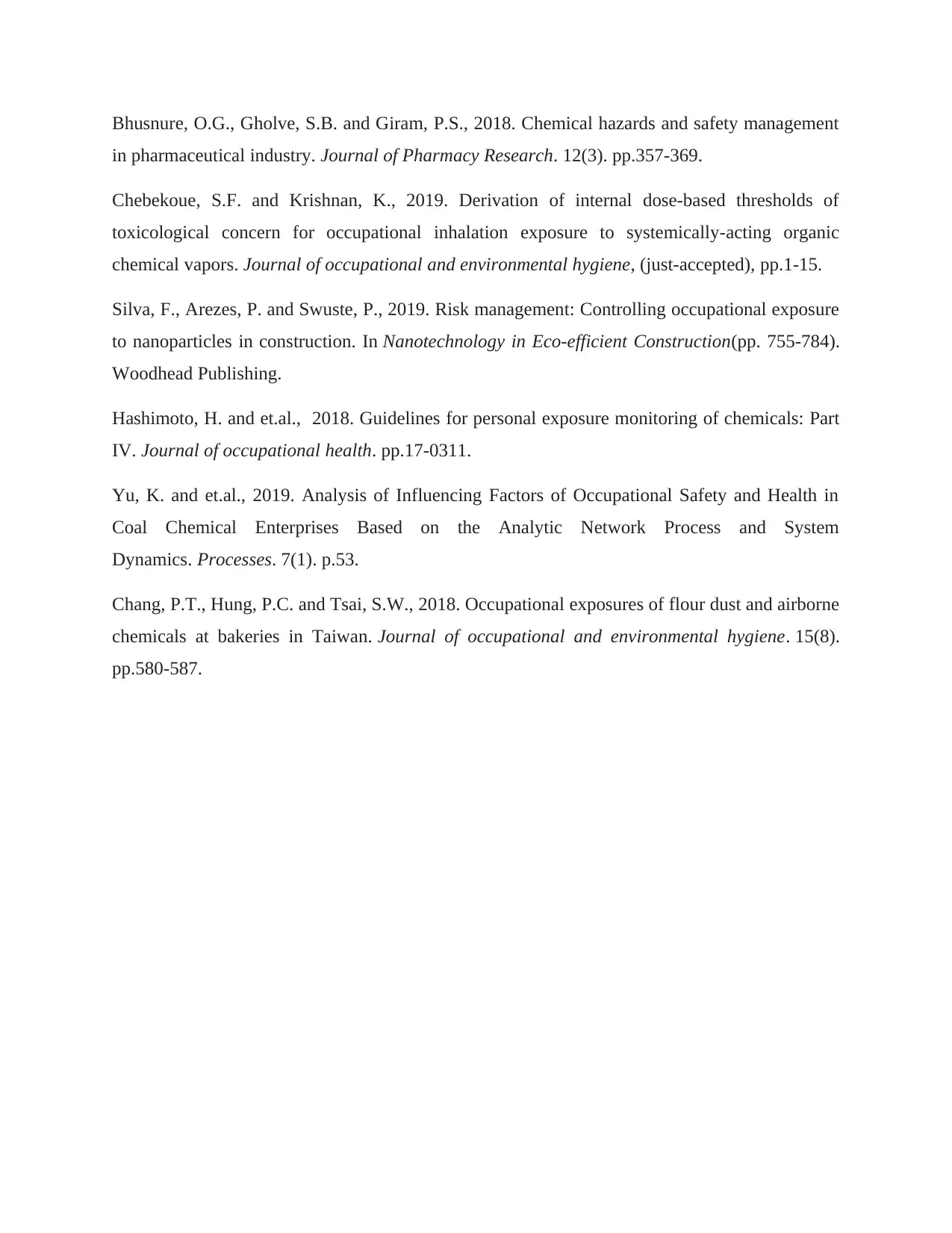
Bhusnure, O.G., Gholve, S.B. and Giram, P.S., 2018. Chemical hazards and safety management
in pharmaceutical industry. Journal of Pharmacy Research. 12(3). pp.357-369.
Chebekoue, S.F. and Krishnan, K., 2019. Derivation of internal dose-based thresholds of
toxicological concern for occupational inhalation exposure to systemically-acting organic
chemical vapors. Journal of occupational and environmental hygiene, (just-accepted), pp.1-15.
Silva, F., Arezes, P. and Swuste, P., 2019. Risk management: Controlling occupational exposure
to nanoparticles in construction. In Nanotechnology in Eco-efficient Construction(pp. 755-784).
Woodhead Publishing.
Hashimoto, H. and et.al., 2018. Guidelines for personal exposure monitoring of chemicals: Part
IV. Journal of occupational health. pp.17-0311.
Yu, K. and et.al., 2019. Analysis of Influencing Factors of Occupational Safety and Health in
Coal Chemical Enterprises Based on the Analytic Network Process and System
Dynamics. Processes. 7(1). p.53.
Chang, P.T., Hung, P.C. and Tsai, S.W., 2018. Occupational exposures of flour dust and airborne
chemicals at bakeries in Taiwan. Journal of occupational and environmental hygiene. 15(8).
pp.580-587.
in pharmaceutical industry. Journal of Pharmacy Research. 12(3). pp.357-369.
Chebekoue, S.F. and Krishnan, K., 2019. Derivation of internal dose-based thresholds of
toxicological concern for occupational inhalation exposure to systemically-acting organic
chemical vapors. Journal of occupational and environmental hygiene, (just-accepted), pp.1-15.
Silva, F., Arezes, P. and Swuste, P., 2019. Risk management: Controlling occupational exposure
to nanoparticles in construction. In Nanotechnology in Eco-efficient Construction(pp. 755-784).
Woodhead Publishing.
Hashimoto, H. and et.al., 2018. Guidelines for personal exposure monitoring of chemicals: Part
IV. Journal of occupational health. pp.17-0311.
Yu, K. and et.al., 2019. Analysis of Influencing Factors of Occupational Safety and Health in
Coal Chemical Enterprises Based on the Analytic Network Process and System
Dynamics. Processes. 7(1). p.53.
Chang, P.T., Hung, P.C. and Tsai, S.W., 2018. Occupational exposures of flour dust and airborne
chemicals at bakeries in Taiwan. Journal of occupational and environmental hygiene. 15(8).
pp.580-587.
1 out of 17
Related Documents
Your All-in-One AI-Powered Toolkit for Academic Success.
+13062052269
info@desklib.com
Available 24*7 on WhatsApp / Email
![[object Object]](/_next/static/media/star-bottom.7253800d.svg)
Unlock your academic potential
© 2024 | Zucol Services PVT LTD | All rights reserved.





